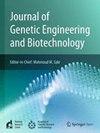家畜饲料添加剂黑曲霉植酸酶的生物信息学研究。
IF 3.5
Q3 Biochemistry, Genetics and Molecular Biology
Journal of Genetic Engineering and Biotechnology
Pub Date : 2023-12-01
DOI:10.1186/s43141-023-00600-y
引用次数: 0
摘要
背景:饲粮中添加植酸酶可降低其植酸组成,以提高其营养价值。黑曲霉是一种能够编码植酸酶的真菌。本研究旨在确定其编码植酸酶的DNA序列特征和氨基酸组成,并确定引物设计。方法:本研究采用人工从NCBI和PDB采集的黑曲霉基因序列数据和编码蛋白质的植酸酶。使用SPDBV对数据进行分析,然后使用ClustalW多重对齐功能对数据进行对齐。系统发育树是由Mega11软件构建的。从分析的候选序列中设计引物。然后使用FastPCR和SnapGene软件对设计的引物进行PCR模拟。结果:NCBI中存在黑曲霉植酸酶18种,占总数的14.87%。有14种黑曲霉植酸酶具有95%以上的同一性。黑曲霉110。M94550.1是最接近PDB模板的应变。植酸酶基因的候选来源为黑曲霉110.M94550.1、48.2.BCMY01000003.1和92.JQ654450.1。底漆设计有自退火和反向底漆高熔点两种可能。PCR模拟结果表明,该引物设计可以完全附着,但仍存在误引的可能性。结论:本研究为今后利用基因工程技术开发黑曲霉生产植酸酶作为饲料添加剂,提高印尼家畜饲料质量提供了良好的前景。本文章由计算机程序翻译,如有差异,请以英文原文为准。
Bioinformatics study of phytase from Aspergillus niger for use as feed additive in livestock feed
Background
Phytase supplementation in rations can reduce their phytic acid composition in order to enhance their nutritional value. Aspergillus niger is a fungus that can encode phytase. This study aims to determine the characteristics of its DNA sequences and amino acid composition that encode the phytase enzyme, as well as to determine the primer designs.
Method
This study used gene sequence data and protein-encoding phytase from Aspergillus niger that was collected manually from NCBI and PDB. The data was analyzed using SPDBV and then be aligned using the ClustalW Multiple Alignment features. The phylogenetic tree was built by Mega11 software. Primers were designed from selected candidate sequences that were analyzed. The designed primers were then simulated for PCR using FastPCR and SnapGene software.
Results
There are 18 Aspergillus niger phytases in NCBI which is 14.87% of the total Aspergillus. There are 14 Aspergillus niger phytases that have identity above 95%. Aspergillus niger 110. M94550.1 is the closest strain to the PDB template. Candidate sources of phytase genes are Aspergillus niger 110.M94550.1, 48.2.BCMY01000003.1, and 92.JQ654450.1. The primer design has 2 possibilities of self-annealing and high melting temperature on the reverse primer. PCR simulation shows that the primer design can attach completely but still has the possibility of mispriming.
Conclusion
This study suggests promising results for the future development of phytase enzyme production from Aspergillus niger as a feed additive using genetic engineering to enhance the quality of livestock feed in Indonesia.
求助全文
通过发布文献求助,成功后即可免费获取论文全文。
去求助
来源期刊

Journal of Genetic Engineering and Biotechnology
Biochemistry, Genetics and Molecular Biology-Biotechnology
CiteScore
5.70
自引率
5.70%
发文量
159
审稿时长
16 weeks
期刊介绍:
Journal of genetic engineering and biotechnology is devoted to rapid publication of full-length research papers that leads to significant contribution in advancing knowledge in genetic engineering and biotechnology and provide novel perspectives in this research area. JGEB includes all major themes related to genetic engineering and recombinant DNA. The area of interest of JGEB includes but not restricted to: •Plant genetics •Animal genetics •Bacterial enzymes •Agricultural Biotechnology, •Biochemistry, •Biophysics, •Bioinformatics, •Environmental Biotechnology, •Industrial Biotechnology, •Microbial biotechnology, •Medical Biotechnology, •Bioenergy, Biosafety, •Biosecurity, •Bioethics, •GMOS, •Genomic, •Proteomic JGEB accepts
 求助内容:
求助内容: 应助结果提醒方式:
应助结果提醒方式:


